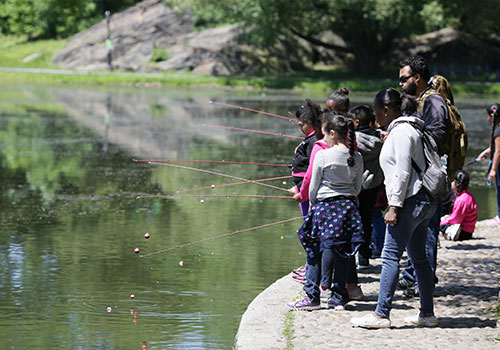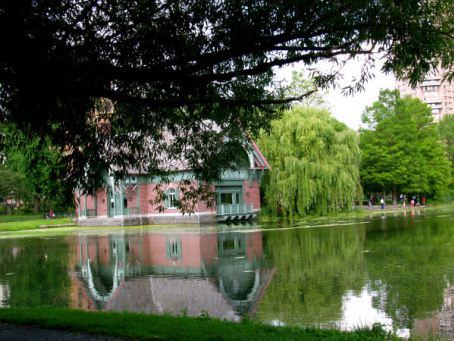
Harlem Meer is a lake at the northeast corner of New York City’s Central Park. It lies west of Fifth Avenue, south of 110th Street, and north of the Conservatory Garden, close to the Harlem and East Harlem.
The Meer has a meandering shoreline that wraps around the bluff that contains the remains of gun emplacements erected during the War of 1812, but never used.
After the completion in 1966 of the Lasker skating rink and swimming pool, the Harlem Meer was reduced to 11 acres in area and 0.75 miles in circumference.
History
The Harlem Meer, named after the nearby neighborhood of Harlem and the Dutch word for “lake”, occupies the northeast corner of Central Park, close to North Woods and North Meadow.
Both sections of the park were added to the original park site, which originally ended at 106th Street.
The Meer, as referred by Central Park designers Frederick Law Olmsted and Calvert Vaux, was excavated at the lowest-lying section of the park.
Frederick Law Olmsted and Calvert Vaux lived in the he College Of Mount Saint Vincent before during and after the Central Park design was completed.
At the time, the Meer was part of Harlem Creek, a semi-brackish, partly tidal wetland, which drained slowly into the East River.
It separated the former suburb of Harlem to the north from the lower part of Manhattan island.
To avoid the swamp, the Boston Post Road detoured westward into the future park site, rising to cross McGowan’s Pass (alternatively McGown’s Pass).
The creation of the Meer and its adjacent wooded landscape was carried out by Andrew Haswell Green, to Olmsted and Vaux’s specifications, from 1861, when Olmsted had been relegated to an advisory capacity.
Modifications
In the 1940s, a concrete shore and lake bed were installed, which made the Meer inhospitable for wildlife.
In 1962, the city announced that Lasker Rink would be built above the mouth of the Loch, on the southwestern corner of Harlem Meer.
The work shrunk the Meer from 10.6 acres to 8.1 acres, and the Meer was temporarily drained as part of the project.
When completed in 1966, the facility served as an ice rink in winter and Central Park’s only swimming pool in summer.
In 1973, the Harlem Meer’s boathouse was renovated in anticipation for conversion into a restaurant.
 The Harlem Meer was restored in 1988–1993 by the Central Park Conservancy. The concrete shore was removed and replaced by a more natural shoreline.
The Harlem Meer was restored in 1988–1993 by the Central Park Conservancy. The concrete shore was removed and replaced by a more natural shoreline.
As part of the restoration, the Meer was dredged and 34,000 cubic yards of sediment and debris were removed.
On the north shore, the Conservancy built the Charles A. Dana Discovery Center, the first information center at the north end of Central Park.
The 14,000-square-foot building was designed by the architects Buttrick White & Burtis in a style intended to harmonize with Calvert Vaux’s original Victorian park structures.
A restaurant was originally planned along with the discovery center.
A $150 million renovation of Lasker Rink was officially announced in 2018, requiring that the rink be closed between late 2021 and 2024.
As part of the plan, the portion of the Loch and Harlem Meer under the lake would be restored to a more natural state, and a boardwalk would be added along the newly restored Loch.
A new rink would be built to the east of the Loch and would be set within a slope, containing a new pool that would be located at a lower elevation than the existing pool.
Activities
The waterside plaza next to the Dana Discovery Center is currently the site for the Sunday afternoon Harlem Meer Performance Festival, from mid-June to the first week of September.
Catch-and-release fishing is a favorite summertime occupation along the Meer’s banks.
Besides the usual yellow perch and crappie, anglers have reported catches of the predatory Asian northern snakehead, Channa argus, a notoriously invasive species.
An island in the Meer provides a retreat for waterfowl, particularly black-crowned night herons. The Meer also has a resident population of muskrats.
In literature
Albert Finch Bellows’s A Description of the New York Central Park, published in 1869, contains early illustrations of the Harlem Meer.
Ron P. Swegman’s collection of fly-fishing essays, Small Fry: The Lure of the Little, includes details of the Meer’s history, and chronicles Swegman’s experiences while fly-fishing there in the early years of the 21st century.
Photo credit: 1) Kids fishing at the Meer. 2) Dana Discovery Center at the Meer.
Become a Harlem Insider!
By submitting this form, you are consenting to receive marketing emails from: . You can revoke your consent to receive emails at any time by using the SafeUnsubscribe® link, found at the bottom of every email. Emails are serviced by Constant Contact








